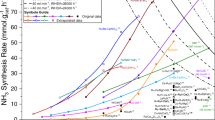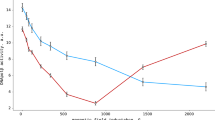Abstract
KINETIC studies of the decarboxylation of phenylmalonic acid in aqueous solution in the presence of high concentrations of rare-earth ions show that diamagnetic ions have little effect on the rate of reaction, while the paramagnetic dysprosium ion leads to an acceleration in rate of the order of 10 per cent1,2. Rare-earth ions do not appear to become co-ordinated appreciably with phenylmalonic acid. Since any magnetic effect must be a very sensitive function of the distance between catalyst and substrate, a study is now being made of the kinetics of decarboxylation of an acid, the anions of which are known to become co-ordinated more strongly with metal ions.
This is a preview of subscription content, access via your institution
Access options
Subscribe to this journal
Receive 51 print issues and online access
$199.00 per year
only $3.90 per issue
Buy this article
- Purchase on Springer Link
- Instant access to full article PDF
Prices may be subject to local taxes which are calculated during checkout
Similar content being viewed by others
References
Pitzer, K. S., and Gelles, E., J. Amer. Chem. Soc., 75, 5132 (1953).
Gelles, E., and Pitzer, K. S., J. Amer. Chem. Soc., 77, 1974 (1955).
Pedersen, K. J., Acta Chem. Scand., 6, 285 (1952).
Prue, J. E., J. Chem. Soc., 2331 (1952).
Wheelwright, E. J., Spedding, F. H., and Schwarzenbach, G., J. Amer. Chem. Soc., 75, 4196 (1953).
Author information
Authors and Affiliations
Rights and permissions
About this article
Cite this article
GELLES, E. Magnetic Catalysis of the Decarboxylation of Oxaloacetic Acid. Nature 176, 925–926 (1955). https://doi.org/10.1038/176925b0
Issue Date:
DOI: https://doi.org/10.1038/176925b0
This article is cited by
-
Kinetics of dehydrogenation and dehydration of isopropyl alcohol and dehydrogenation of tetralin on gadolinium oxide
Bulletin of the Academy of Sciences of the USSR Division of Chemical Science (1962)
-
Carbon-13 Isotope Effects in the Decarboxylation of some Oxaloacetates
Nature (1955)
Comments
By submitting a comment you agree to abide by our Terms and Community Guidelines. If you find something abusive or that does not comply with our terms or guidelines please flag it as inappropriate.



